Exciting News! PayrollHero is now on Reddit! Join us at r/payrollhero for the latest updates, discussions, and direct chats with our team. Your voice matters, so dive in now! — https://reddit.com/r/payrollhero/ #PayrollHeroOnReddit


Exciting News! PayrollHero is now on Reddit! Join us at r/payrollhero for the latest updates, discussions, and direct chats with our team. Your voice matters, so dive in now! — https://reddit.com/r/payrollhero/ #PayrollHeroOnReddit

Exciting news – PayrollHero just hit the big 10! 🎉🥳 We’ve been on this journey together, and we want to take a moment to celebrate and reassure you about your data’s security.
🔐 A Decade Strong – Zero Security Breaches:
Guess what? We’ve had your back for 10 years, and not a single security breach! Your data is as safe as ever.
💪 We’re Always Improving:
We’ve been investing in top-notch tech, regular security checks, and staying ahead of the game to keep your info locked down. We take security seriously, and we’re not slowing down.
🙏 Thanks for Trusting Us:
Big shoutout to you – our awesome community! Whether you’re a long-timer or a newbie, your trust keeps us going. We couldn’t have hit this milestone without you.
🚀 What’s Next? Share Your PayrollHero Story:
We want to hear from YOU! Drop a comment and tell us about your PayrollHero journey. What features do you love? How has it helped you? We’re all ears.
Here’s to a decade of success, and many more to come!
Often times, companies generate payroll and pay out an entire month’s wages to an employee before the month has ended. We call this assuming payroll. This is how it works: If payroll is generated an the 25th and paid out on the 27th, the manager pays the full month’s wages, up till the 31st, assuming that the employee will make it to work on the last few days. If he doesn’t, the manager 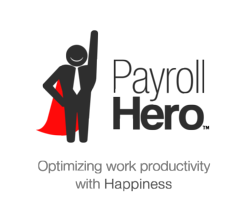 needs to deduct his wage in the next month
needs to deduct his wage in the next month
Assuming payroll is an inefficient and inaccurate way of paying employees. We’ve come across many business owners who do it in Singapore. Most of the time, it’s because they have been doing it for years and have never thought about changing the rule. We help our clients transition from assuming payroll to regular payroll which saves clients money and time. Here is a blog post on exactly how to transition from assuming to regular payroll.
Irregular Clock-in Timings
When an employee clocks in at 8.57am instead of 9.00am, the biometric device records it to the exact minute. Your HR manager needs to manually correct the irregularity because coming in 3 minutes early does not mean that the employee will get paid for those extra three minutes.
The PayrollHero app has a threshold feature that solves this problem. An HR manager can set a threshold: if an employee clocks in between 8.55am and 9.05am, their clock-in time resets to 9.00am, automatically correcting the irregularity that your HR manager would have had to deal with otherwise.
Disparate Systems for Time, Attendance, Scheduling and Payroll
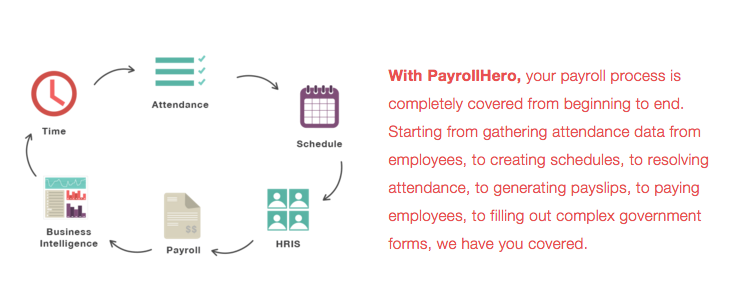 Business owners have multiple systems that deal with different HR problems; a biometric device to measure clock ins, a separate Excel sheet that imports data from the biometric device and generates payroll, another Excel sheet that needs to be updated every week with schedules for each employee and a whole other system that employees use to apply for leave. With so many systems to deal with, no wonder an HR manager barely has any time to engage with employees or find innovative ways to overcome Singapore’s labor crunch.
Business owners have multiple systems that deal with different HR problems; a biometric device to measure clock ins, a separate Excel sheet that imports data from the biometric device and generates payroll, another Excel sheet that needs to be updated every week with schedules for each employee and a whole other system that employees use to apply for leave. With so many systems to deal with, no wonder an HR manager barely has any time to engage with employees or find innovative ways to overcome Singapore’s labor crunch.
An end-to-end solution that removes any need for multiple devices is exactly what an HR manager needs. PayrollHero allows employees to click selfies on their phone or an iPad in the work site when they clock in. This data is stored in the Cloud and used when payroll is generate by the system. The same app is used when applying for leave or checking schedules for the week. An HR manager can use the app on his laptop, phone or any device with internet connection anywhere in the world and have full control over what is going on at his work site.
While these problems are seen as some of HR managers’ biggest in Singapore, they are faced by managers in the Philippines and pretty much any other place too. Some of the other problems HR managers need to deal with are changing tax laws, a labor crunch and laws against foreign workers in the country.
We hope that this post serves as a solution to some of your biggest HR problems. Do let us know your biggest HR problem and how you are currently dealing with it.
 We recently announced that PayrollHero can generate employee happiness reports for our clients. What does that really mean?
We recently announced that PayrollHero can generate employee happiness reports for our clients. What does that really mean?
PayrollHero takes in data in the form of selfies that employees have clicked on the app. The selfies are used to evaluate employee happiness by looking for certain metrics and correlating them to other selfies. For example, smiling for photos results in a different set of facial expressions than a serious face.
We know what you’re thinking. What if an employee smiles but isn’t really happy. Faking a smile is not hard and the metrics used to evaluate a real smile are the same as those used to evaluate a fake one. An employee could easily fool the app into thinking that the employee is happy when she really isn’t. Well, faking a smile has its own merits.
A Harvard study showed that a smile – whether fake or real – can be uplifting for one’s emotional well being. Granted, a momentary smile for a selfie certainly does not equate to happiness in life because a smile can be fake; but the act of smiling itself is a positive way to cope with sadness. Our preconceived notion that happiness causes us to smile is not always true. In fact, the reverse of that can work as well. A fake smile may be a better path towards happiness than others. It signals a willingness to stay positive in difficult times instead of suppressing ill feelings.
How does this relate to happiness reports? Well, from a high level, the happiness reports suggest a correlation between smiling and happiness and therefore suggest which employee or work site is the happiest. But with deeper inspection, the reports find a correlation between smiling and employees’ positive attitude. As a manager, you should consider the happiness report as a way of measuring positive sentiments in your workforce.
Finally, PayrollHero can use this data against employee records to find a trend in employee behavior. We can provide insight into whether happier employees are generally more punctual; whether unhappy employees experience a longer commute to work everyday; whether the happiest worksite equals highest earnings. This information is unique to PayrollHero’s data. Companies can leverage on it to make more informed decisions on what it takes to improve their bottom line.
Want to learn more? Contact us to chat further.
My ten-week internship with PayrollHero reached its end last week. As a fitting closure to my first post on hiring interns in Singapore, I thought it would be a good idea to write about my experience here. I’ve had an amazing summer at PayrollHero and learned more than I thought I would. Ten weeks flew by and it took a few days to organize my thoughts. Here is what I learned from my internship at a startup in Singapore.
 Lesson 1: Learning is built in to PayrollHero’s DNA
Lesson 1: Learning is built in to PayrollHero’s DNA
The company doesn’t just declare its “Ridiculously Client Focused” psyche on the website, it lives and breathes the idea. To achieve that end, everyone is always learning new things through whichever means that they can. But it doesn’t end at just learning something by yourself, it’s all about sharing it with everyone else. When I joined the communication channel, Slack, the most interesting channel to me was the reading-list. A mandatory channel for all members, the reading-list includes articles that are relevant to the team from all kinds of sources. Anyone can share something that they have read, and anyone can comment on it.
One of the first things I did at PayrollHero was to broaden my reading base. As an economics student, the obvious reading material I blindly follow are opinion blogs by economists, or economics journals, and of course, the newspaper. But within two weeks, I had apps on my phone that gave me news about startups, tech blogs and more. It was awesome to see that everyone was invested in improving themselves and the team. It was also interesting to see what everyone was reading. Rarely does a college kid get the chance to find out what seasoned entrepreneurs are reading. And here I was, discussing the very articles with the founders of PayrollHero.
Lesson 2: You’re an intern, and you’re still taken seriously
Trust me, this one was huge. While I was interning at PayrollHero, I had friends interning at big accounting firms, consultancies and banks. I would often hear stories about their internships where all they did was photocopy documents for their bosses. This was not the case across the board, but I heard it often enough to realize that my internship was unique.
During the ten weeks, I never once had the impression that I was just an intern slaving away at something inconsequential. If it ever seemed like I was not doing enough, I could speak up about it and get more work to do. The great thing about working in a small place is that there is always something to do and the little that you contribute has a visible impact on the company. Furthermore, Steve ensured that the communication lines were open and that an intern in the Business Development team was equally important (and accountable) as any other member on the BD team. The feeling of being a relevant member of a team is definitely something that I will take with me from this internship.
Lesson 3: Diversity
When I read about PayrollHero before sending in my resume, I loved the idea of Adventure Engineering and knew that PayrollHero was based in the Philippines, Singapore and Canada. To me, that seemed to reflect diversity well enough until I met the team. If you hang out with the Singapore team, you will find yourself in a room with around 10 people representing at least 7 different nations. That is incredible and speaks volumes to the success of PayrollHero’s drive to attract talent, no matter where it comes from.
There are many studies that show how diversity improves results in a company. Diversity was a crucial aspect in my experience. Despite being an international student studying in a foreign country, I had never seen so many nationalities from across the world working together before I showed up at PayrollHero. Imagine this, a Canadian, Ukrainian, Polish, Indian and Filipino sitting in a hawker center, eating a plate of prata and talking about the latest episode of Game of Thrones. As ridiculous as that sounds, it’s just another regular day at PayrollHero. You can’t help but appreciate how easily PayrollHero has embodied the concept of diversity in a company.
Lesson 4: Hanging out with the team over beers
If I look back over the ten weeks I was at PayrollHero, some of the most memorable interactions with the team was not during work, but outside it, when everyone hung out with some beers after a long day of work. I learned the most about the people who make up PayrollHero during this time. Whether it was about their professional lives or just a casual conversation about what everyone’s “ah-ha!” moment was during the DDD workshop, these interactions helped me understand people in a world I had little or no idea about.
I think this is especially invaluable to interns because a large part of interning is to try and figure out what to do with our lives professionally. While colleges make an effort to conduct networking sessions with professionals from every field, it does not come anywhere close to actually spending time with the same people day in and day out.
Finally, all these elements together made for an internship that immensely broadened my perspective. When I first walked into PayrollHero, I wondered if an unstructured internship would teach me anything new or if the work would be rewarding. But the truth is, the very fact that it was an unstructured program made me want to push myself to do new things and be open to ideas that I wasn’t exposed to before. At the end of it, I came away having met inspiring people from all over the world, learning about the startup culture and learning more about myself through it all. I hope the little work I did at PayrollHero was useful to the company. I also greatly appreciate the time invested by Steve and Mike and everyone else to make my internship worth it. At the risk of sounding super cheesy right now: good luck, PayrollHero, and may the force be with you!
Editors Note: Thanks Pragya!! While Pragya is off on her next adventure you will still see her posting on the PayrollHero blog a few times a month.
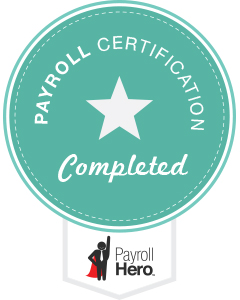 Last week, Kieran our Head of Client Success, conducted training sessions for the new PayrollHero team members in Singapore as well as a few clients. We got some hands on experience with the app, which helped us gain a deeper understanding of how the product works. As an intern who has been here for a few weeks, my knowledge about the product came from speaking with team members, listening to sales pitches and reading about the product online. So it was an interesting experience to use the product on a demo account and view it from the perspective of a payroll administrator. All new PayrollHero team members get certified on the platform so that they know exactly what the platform can do.
Last week, Kieran our Head of Client Success, conducted training sessions for the new PayrollHero team members in Singapore as well as a few clients. We got some hands on experience with the app, which helped us gain a deeper understanding of how the product works. As an intern who has been here for a few weeks, my knowledge about the product came from speaking with team members, listening to sales pitches and reading about the product online. So it was an interesting experience to use the product on a demo account and view it from the perspective of a payroll administrator. All new PayrollHero team members get certified on the platform so that they know exactly what the platform can do.
Kieran took us through every aspect of the product. My first thought when I was told about the training was, “Wow, a two and a half day training session? But I already know everything about it!” Which, as you may have guessed, turned out to be highly overstated. Within the first two hours of training, I came to the conclusion that the product was far more powerful than I had expected.
The first day was about Human Resources Information Systems (HRIS). The next day was spent on generating payroll and the final day was dedicated to understanding time, attendance and scheduling using the app.
The interesting part about the app is its customization capabilities. A human resources (HR) administrator can record the company’s organizational chart. The hierarchy allows you to identify employee types and positions. Thresholds allow you to set rules on what kinds of notifications you get based on the activities of employees under you in the hierarchy. The thresholds have multiple permutations and combinations that, once customized, help you prioritize information that you need instantly versus information that can wait till a more suitable time.
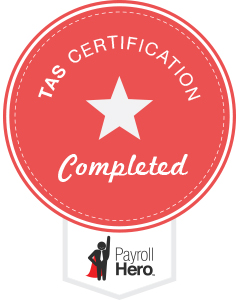 It didn’t stop there. Customization extended to how you segment payroll: employer contributions (CPF, SDL, FWL), bonuses, vacation payments, advance payments, claims that need to be redeemed. Any kind of payment outside of the basic calculation of an employee’s hourly wages can be segmented and customized so that all a payroll administrator has to do, is enter which segment the payment should go into. The app can take care of debiting/crediting the amount to the required account. It will notify you when the account is hitting a pre-recorded limit. The flexibility of the app went as far as allowing you to import data from a spreadsheet, allowing the app to automatically fill in employee details.
It didn’t stop there. Customization extended to how you segment payroll: employer contributions (CPF, SDL, FWL), bonuses, vacation payments, advance payments, claims that need to be redeemed. Any kind of payment outside of the basic calculation of an employee’s hourly wages can be segmented and customized so that all a payroll administrator has to do, is enter which segment the payment should go into. The app can take care of debiting/crediting the amount to the required account. It will notify you when the account is hitting a pre-recorded limit. The flexibility of the app went as far as allowing you to import data from a spreadsheet, allowing the app to automatically fill in employee details.
While all of this might seem like a rather dry topic to train on for nearly three days, Kieran managed to make the whole session more interesting by throwing in quizzes and having interactive sessions. Every demo account had characters from Kieran’s favourite fiction series. Homer Simpson got a bonus for his outstanding work (let’s pretend like that is EVER going to happen), Sherlock Holmes got promoted to the next level on the org chart, Buffy Summers asked for a change in her schedule for the next 3 weeks and Harry Potter recorded coming in early to work consistently. All these characters were a part of the certification exercises, which made the entire process not only informative but also engaging.
The time, attendance and scheduling part of the course was done through an online training portal on the PayrollHero website. Again, I was pleasantly surprised by how detailed the app was and how customizable the entire process of scheduling was. It was impressive that the app was user friendly and flexible with creating, adjusting or removing schedules based on timing, location and type of work: whether it was a routine desk job or a part time job that required changing schedules often. The app, as was intended, was perfectly designed for retailers and restaurant owners who deal with employees who have erratic schedules which require constant adjustments.
The exercises and quizzes were effective in understanding how much we grasped from the lessons. It was clear that working with app required you to be consistent and methodological with the processes for entering data, giving system permissions, organizing the company’s hierarchy and setting customized options especially since the data that the system works with is sensitive. Finally, the certification undoubtedly served its purpose: it gave us a complete picture of how the app works and how a payroll administrator can benefit by using all its features for time, attendance, scheduling and payroll.
Learn more about PayrollHero Certification in the Philippines and Singapore.
The PayrollHero offices are buzzing with new energy. This week, the entire team flew in from Manila and Whistler to Singapore and worked through two days of intense training on Domain Driven Design with Kiro Harada. After the rigorous learning retreat, the team emerged with renewed perspective and restless enthusiasm. In an endeavour to contribute to our community, we want to share with you what Kiro taught us.
The learning retreat was conducted by lean and kaizen expert Mr. Kiro Harada. Kiro flew in from Japan and spent time with us both as part of the workshop and to guide us after it.
Domain Driven Design is all about communication. The gap between what developers want to create and what stakeholders in the company understand can be massive, potentially detrimental to the company. Even between developers, it is hard to maintain a common language as domains grow larger. This makes it tougher to model a problem which leads to further miscommunication.
Blind men and the elephant
For you and me, miscommunication sounds like an obvious problem. But what does it mean in a tech company for people who are not familiar with domains and modelling? To give us an idea of what he meant, Kiro told us about the 5 Blind Men and the Elephant. Each blind man gets a part of the elephant: like the leg, the trunk or the tail. Individually, the blind men know everything about their allotted parts. But when they regroup, one man calls his part a tree, the other man calls his part a snake, and so on.
Different perspectives colour reality and computer programmes cannot distinguish between the two. So what can you do to ensure that everyone is on the same page? The solution to the Blind Men and the Elephant problem is for each blind man to observe his part, regroup, model (or draw) what they observed, go back, make observations and repeat the process till they finally put it all together. You collect information and switch positions to ensure that everyone’s perspectives are clearly understood. The idea is to move from a state of –
Not knowing what you don’t know (or alternatively, knowing what you know)
to
Knowing what you don’t know
DDD is intended to take you back to the drawing board, where you design incrementally. The model must constantly evolve – from building a scenario that describes a model which is written into code that creates new scenarios, and the loop regenerates itself. Exploring models with creative collaboration while consciously focusing on the core domain is what DDD helps you do.
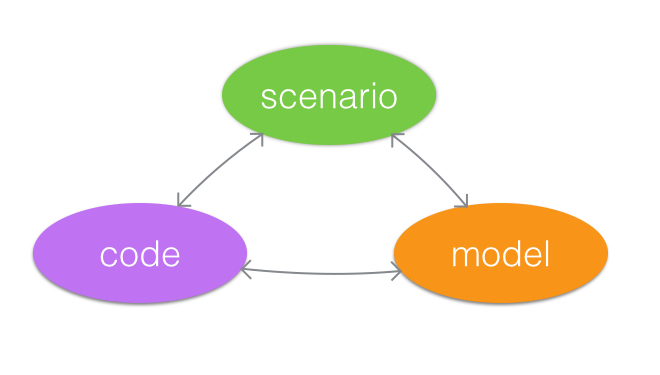
DDD in Practice: Modelling a Vending Machine
The concept of DDD can be vague unless you put it into action. Kiro chose to do just that by splitting us into teams and giving us a problem to model. The only instructions were to code for a vending machine.
Round 1: True to PayrollHero’s style, my team decided to code for a machine that vends beer. We got down to writing all components involved in the machine: beer, a tray to hold the beer, a coin collection box, refrigeration involved (liquid nitrogen, of course), landing tray, the works. We then wrote down all the actions involved, inserting the coin, choosing a brand, waiting for the beer. Then we wrote down all possible scenarios: what if too many coins were inserted, what if the power ran out, what if the machine go stuck while vending the beer, what if the beer wasn’t cold, what if… and we went on and on.
Till Kiro came up to us and said our time was up.
We got no coding done. We barely opened a laptop screen. There was no product, just a bunch of ideas. Round one was an epic failure. We had a brief discussion on what to do. Kiro told us we needed to start small. Create a scenario, build a model, implement it and then go back to the drawing board to create another scenario.
Round 2: We needed a fresh perspective. We started from scratch, this time making sure that the developer in the room coded while we built the model. The process seemed slow but was far more efficient. Every non-developer would review the code to make sure everyone understood what was going on. When time was up we had our minimum viable product. By making our core domain small, we had a flexible model that we could work around. It was evident that Domain Driven Design helped us create our MVP within 45 minutes.
Timeboxing: The Bomb
In theory, DDD now seems like a simple idea. Even when you are modelling a vending machine, applying DDD to one problem is easy. What if you are dealing with 20 different problems at a time? Kiro showed us how multi-tasking can wreak havoc on a team. We were made to stand in a circle and pass around a “bomb” in alphabetical order. We were just getting good at it, when Kiro threw in another bomb that we were supposed to pass around in height order. A few seconds later another bomb was introduced that was to work its way around the group in order of birthdays. As you would imagine, we took ages figuring out how to pass three bombs around simultaneously. It was inefficient, messy and absolutely hilarious.
The idea of multi-tasking is just not sustainable. It wastes time and does not capture anyone’s complete focus. Timeboxing is far more effective. Getting work done one at a time allows you to apply DDD, keep everyone involved on the same task and thereby get everyone to focus their energies on a single plan.
Day 1 ended on a high note. Kiro threw ideas on modelling different problems at us and the developers enthusiastically practiced on them. The team was exhausted but an idea was borne out of a full day’s worth of training. We had big plans for the future, with new features in the pipeline.
Day 2 picked off from the previous day’s final tip – timeboxing. When you do tasks one at a time, it’s important to prioritize which feature from your backlog should be worked on. At PayrollHero, developers choose a bunch of issues and then vote on them. After ranking the issues, Kiro suggested we vet through what the problem really is before we go deeper into solving it.
Fact vs Opinion
Once you have identified a problem, it’s worth evaluating whether the problem is relevant or even real. Differentiating fact from opinion is another one of those obvious steps but everyone often misses out on it when you are deep into the process of solving a problem. It’s worth hitting the brakes and breaking down the problem and solution.
| Problem | Solution | |
| Fact | The problem should be based on solid data, maybe customer feedback or some other data analytics | A solution that arises from analysing the facts of the problem. A quantifiable improvement is preferable |
| Opinion | What the developers believe the problem is | An opinion about the solution may be a source of new problems or ideas |
Moving from the problem to a solution is what Kiro calls a Hero’s Journey. Using the facts of the problem, developers need to use their imagination to model the solution. The next step is to design the model and then implement the solution. Often the implementation brings up new problems and the cycle begins again. (If you were wondering, the name comes from the Star Wars protagonist, Luke Skywalker, who was faced with the problem of saving the galaxy, then he met Yoda, and finally used the Force to save Princess Leia and bring freedom and peace to the galaxy. Kiro is quite the sci/fi fan).
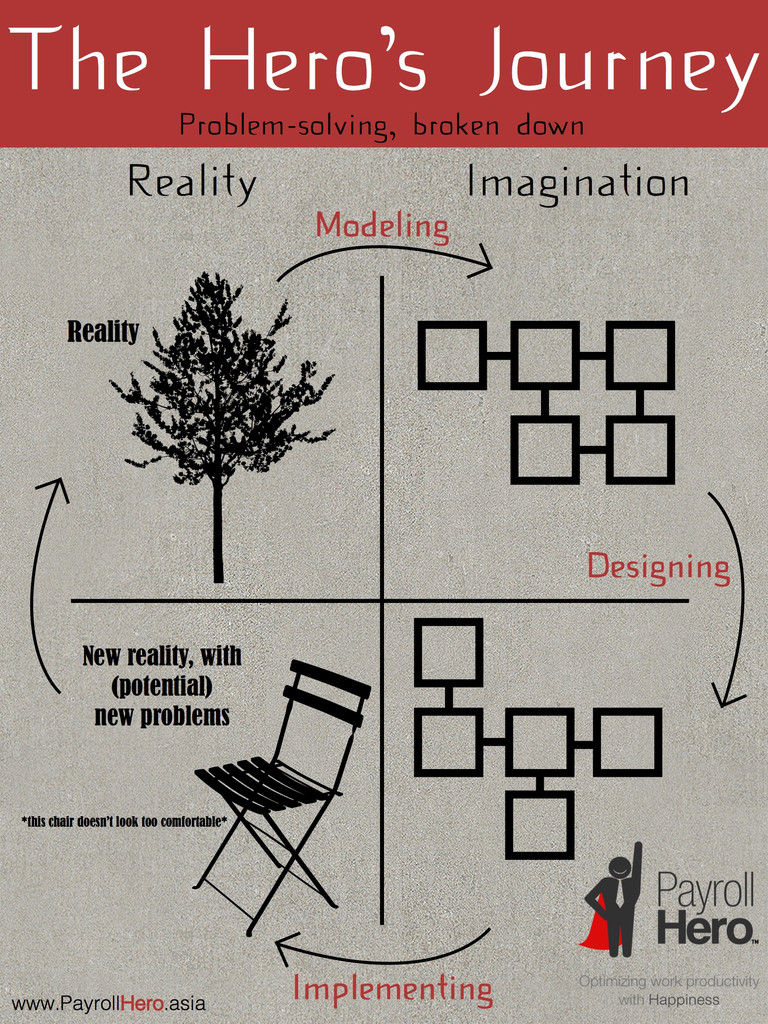
This marked the end of the learning material that Kiro taught us. After this, we talked about models specific to PayrollHero and practised tackling them. An interesting exercise was to build a simple model, say a delivery system, and throw scenarios at it to see where the model breaks. The entire team enjoyed the brain teasers but more importantly, it helped us look at our product with fresh eyes and a different angle to approach our pipeline ideas.
The next few days are all about using DDD for some rigorous introspection and using the new learning as a foundation for future ideas. We also got the entire team to spend some time together with each other and our new interns. We went out for lunch, dinner and drinks. It was a great experience for both developers and non-technical members of the team. Overall, we learned that modeling can and should be used to make decisions, both for R&D and sales and marketing. It was not just about app development, it was a new way of thinking and building on ideas and executing them. While we are constantly improving our methods and changing our approach, we want the PayrollHero team to stay on their feet and continue being awesome consistently.

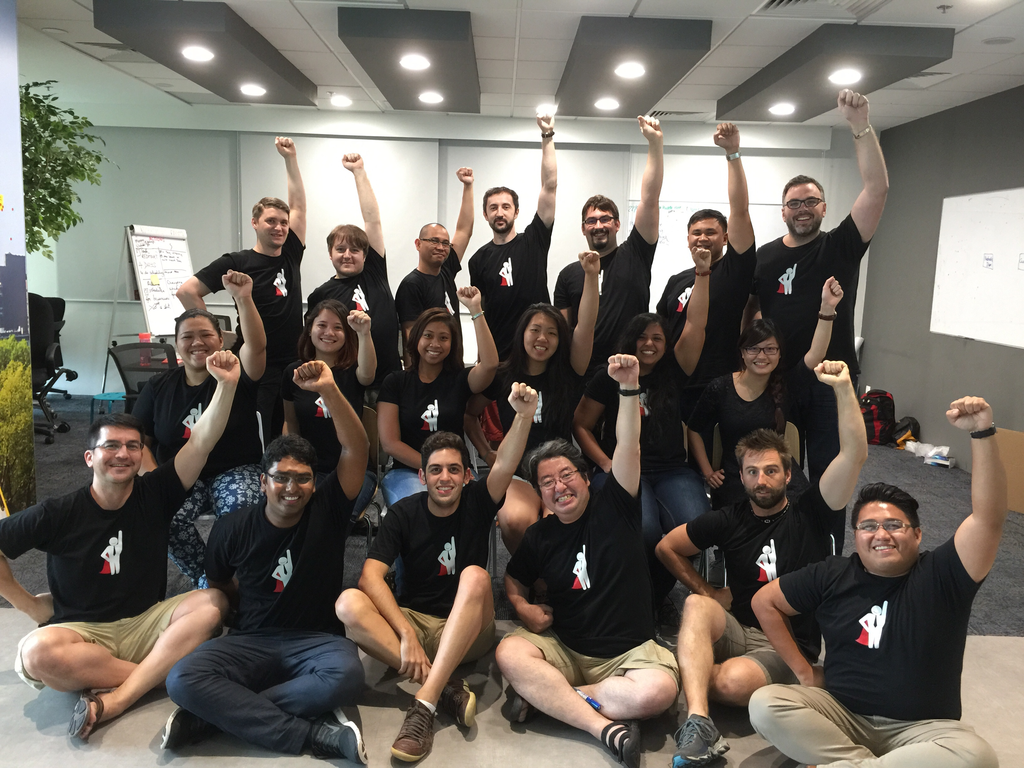
In our recent blog posts on millennials, we’ve talked about how to get the right young star talents into your company and how to stop them from leaving once you’ve got them working for you.

PayrollHero Team is expanding, and as we speak a new batch of interns are flying in to come work with us here at our Singapore office. And it just had me thinking- it is so important to have these young rock stars feel welcome into our working culture. Why? I can understand first hand how daunting it can be for a 20 something year old to travel thousands of miles be apart of something you don’t have a first clue about and figuring all of that out in a new country.
What most employers think when onboarding new employees, they typically check tasks off a to-do list which may include- a quick introduction, an office tour, getting to learn the company vision and other tasks. But what is most often left to last, (and usually ignored) is having a plan that is focused on making new employees feel welcome, appreciated and feel part of the company culture as soon as possible.
And these efforts will have it rewards– high employee retention and loyalty to the company will reflect favorably to the bottomline. Paying close attention to the company culture and adding to it is really important. I would like to quote Jonathan Mildenhall, CMO with Airbnb, where he says “the culture becomes an incubator for creativity
and innovation, and ultimately for business performance.”
Here’s a few things companies can do to welcome a new hire:
Have A Welcome Strategy Put In Place
Before the hiring process starts, have a meeting where everybody (from the management down) who will be involved in the new hire to brainstorm and come up with a detailed plan for bringing a new person to the team. It is important for the company to create a good first impression as well. One of the most important things a new hire at Airbnb goes through is a full week of cultural immersion, so the person will come out of that week feeling like he can be a true ambassador for the company and brand.
Have A Mentor/ Buddy System
It’s good to assign somebody or even better, the whole team to spend some time with the new employee to take him out for lunch or happy hour after work, show how stuff works and provide support when needed. Helping the new guy feel part of the team quickly would be good to help him get rolling on the job and assimilate easier.

Express Genuine Interest in the New Employee As A Person.
Getting to know your new hire as an individual is great for building rapport with the person. Knowing more information about him would come in handy, like for instance if you know he’s visual or auditory will tell you how he prefers to be appreciated. For an auditory person, being complimented verbally is better than receiving it in an email and the opposite is true for a visual person.
It is always good to keep in mind these little information which creates a more personalized welcome and heightens his experience with the company.
Stay tuned to find out who are our new interns and how they are doing with PayrollHero.
The PayrollHero Team is fast expanding and we’re on the look out for rock star talents to join us. Drop us an email and tell us more about you.